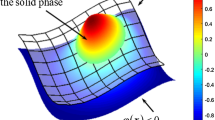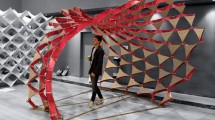Abstract
This paper presents a method for planar development of free-form surfaces especially made of anisotropic materials. A free-form surface is first tessellated into a set of triangular elements (i.e., facet model). If necessary, a facet refinement technique using Euler operators is applied to create a more reliable model that approximates the original surface as closely as possible. The facet model is then roughly flattened on a 2D plane. Next, the roughly flattened model is used as an initial guess for subsequent optimization during which the strain energy method using constant strain triangles (CST) is applied to yield an optimal 2D contour. In fact, various resulting 2D contours can be obtained while varying elasticity ratios between two material axes or development angles. To compare these resulting 2D contours, a contour alignment technique for error estimation is also presented. In this paper, anisotropic materials are considered to be orthotropic as a first approximation. A specific example (lateral surface of a shoe last) is shown to validate the proposed method.
Similar content being viewed by others
References
C. L. Wang, K. Tang and B. Yeung, Freefrom surface flattening based on fitting a woven mesh model, Computer-Aided Design, 37(8) (2005) 799–814.
B. K. Hinds, J. McCartney and G. Woods, Pattern development for 3D surfaces, Computer Aided Design, 23(8) (1991) 583–592.
P. Azariadis and N. Aspragathos, Design of plane developments of doubly curved surfaces, Computer Aided Design, 29(10) (1997) 675–685.
P. Azariadis, A. Nearchou and N. Aspragathos, An evolutionary algorithm for generating planar developments of arbitrarily curved surfaces, Computers in Industry, 47(3) (2002) 357–368.
R. M. C. Bodduluri and B. Ravani, Design of developable surfaces using duality between plane and point geometries, Computer Aided Design, 25(10) (1993) 621–632.
S. H. Kim and K. H. Shin, A method for deforming a surface model using guide surface in shoe design, International Journal of Advanced Manufacturing Technology, 42 (2009) 60–72.
J. Fan, Q. Wang, S. Chen, M. Yuen and C. Chan, A springmass model-based approach for warping cloth patterns on 3D objects, Journal of Visualization and Computer Animation, 9(4) (1998) 215–227.
C. Wang, S. Smith and M. Yuen, Surface flattening based on energy model, Computer Aided Design, 34 (2002) 823–833.
T. Shimada and Y. Tada, Approximate transformation of an arbitrary curved surface into a plane using dynamic programming, Computer Aided Design, 23(2) (1991) 153–159.
W. Chung, S. H. Kim and K. H. Shin, A method for planar development of 3D surfaces in shoe pattern design, Journal of Mechanical Science and Technology, 22 (2008) 1510–1519.
K. Lee, Principles of CAD/CAM/CAE systems, Addison Wesley (1999).
K. S. Lee and S. H. Kim, Non-uniform deformation of an STL model satisfying error criteria, Computer-Aided Design, 42 (2010) 238–247.
T. R. Chandrupatla and A. D. Belegundu, Introduction to finite elements in engineering, Prentice Hall (1997).
B. D. Agarwal and L. J. Broutman, Analysis and performance of fiber composites, John Wiley & Sons (1980).
K. S. Kundert and V. Sangiovanni, A Sparse User’s Guide: A Sparse Linear Equation Solver, Dept. of Electrical Engineering and Computer Sciences, U.C. Berkeley (1998).
ACIS Geometric Modeler: Application Guide, Spatial Technology Inc. (2002).
K. H. Shin, Modeling of time-variant heterogeneous objects in micro-system packages, Journal of Mechanical Science and Technology, 25(5) (2011) 1119–1128.
Author information
Authors and Affiliations
Corresponding author
Additional information
This paper was recommended for publication in revised form by Associate Editor Kyungsoo Kim
Ki-Hoon Shin received his B.S. and M.S. in Mechanical Design & Production Engineering from Seoul National University, Korea and earned his Ph.D from University of Michigan, Ann Arbor, USA. He is currently a professor in the Department of Mechanical Engineering at Seoul National University of Science and Technology, Korea. His research interests are in CAD/CAM/CAE, layered manufacturing, and micro-system packaging.
Rights and permissions
About this article
Cite this article
Shin, KH. A method for planar development of free-form surfaces made of anisotropic materials. J Mech Sci Technol 25, 2817–2825 (2011). https://doi.org/10.1007/s12206-011-0726-z
Received:
Revised:
Accepted:
Published:
Issue Date:
DOI: https://doi.org/10.1007/s12206-011-0726-z




